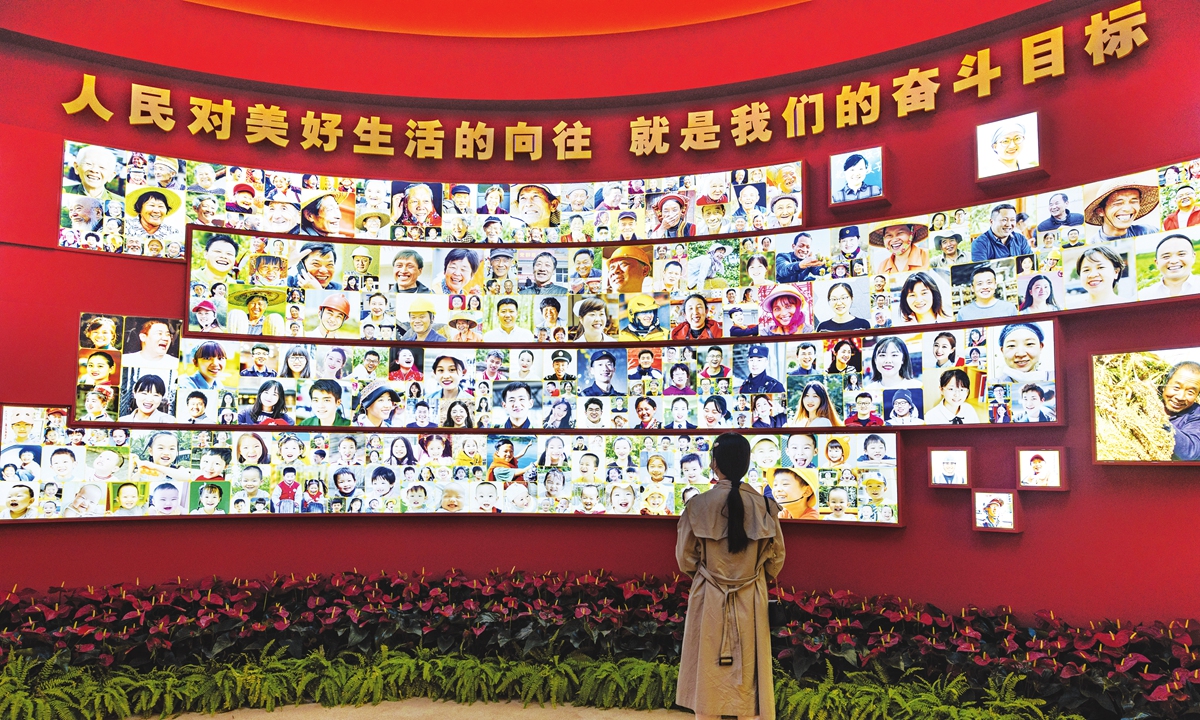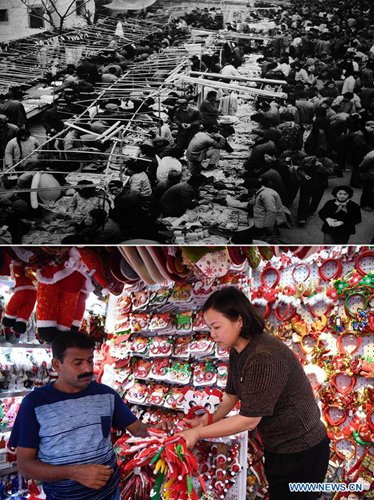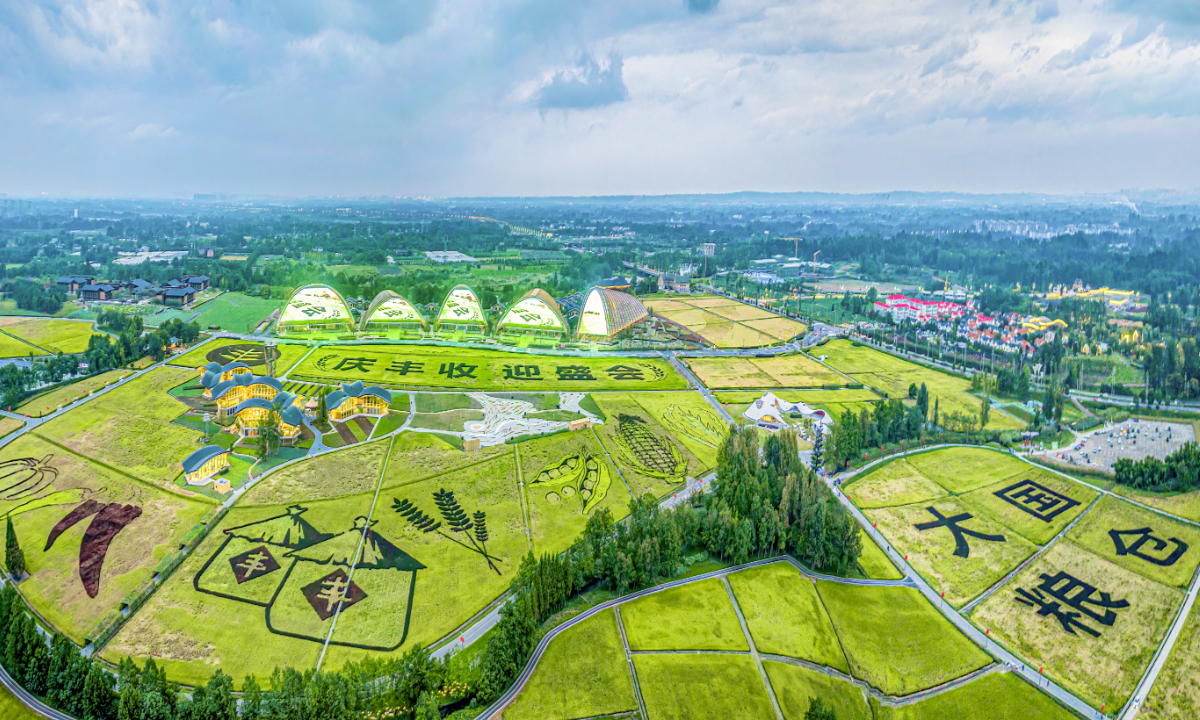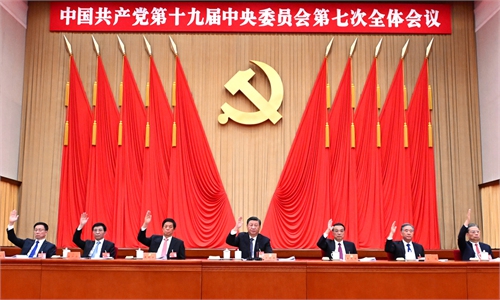
A woman visits an exhibition themed "Forging Ahead in the New Era" on October 2, 2022. The exhibition at the Beijing Exhibition Hall focuses on the great achievements made with the endeavor of the CPC and the country over the past decade. Photo: Li Hao/GT
Editor's Note:
The Communist Party of China (CPC) will convene its 20th National Congress on October 16 to bring China's development to the next stage. This congress is being held after China has accomplished its first centenary goal of building xiaokang - a moderately prosperous society in all respects by 2021 - and to start the second centenary goal of building a modern socialist country that is prosperous, strong, democratic, culturally advanced and harmonious by 2049.
From the founding of the CPC in 1921, the Chinese people took more than two decades to throw off oppression as a semi-colonial, semi-feudal society and found the People's Republic of China in 1949. After the launch of reform and opening-up in 1978 and through the continuous efforts of the Chinese people, China experienced the transformation from a huge, poor and backward country in the East into a thriving socialist China.
Today, after having lauded the great achievements that China has made in the past 100 years, the international community is paying close attention to how it will create a new miracle in a more complicated international environment. It is also necessary to review how the CPC has led the Chinese people to accomplish the first goal, as history always carries the secrets of future success.
This is the first installment of the Global Times' special coverage of the special event.
Jiaxing, a city in East China's Zhejiang Province, has become a "must-visit" place for many Chinese people, especially in recent days, as the 20th National Congress of the Communist Party of China (CPC) gets set to convene. The red boat that anchors off the bank of the Nanhu Lake in Jiaxing and the story that 13 people representing more than 50 CPC members across China adopted the Party's program and proclaimed the founding of the CPC on the boat brought visitors back to the CPC's starting point of leading the Chinese people out of humiliation, poverty and the scourge of war.
The founding of the CPC a hundred years ago was a pivotal event in Chinese history. From the outset, the CPC and the Party members have made the well-being of the Chinese people and the rejuvenation of the Chinese nation its abiding goals.
In October 2017, when the 19th CPC National Congress concluded, the CPC's newly elected top leadership, headed by General Secretary Xi Jinping, visited Nanhu Lake, where they vowed to stay true to the Party's original aspiration and founding mission and serve the people. This was Xi's first domestic trip after the 19th CPC National Congress, and it was also at this congress that China set out a clear timetable and road map to complete building xiaokang — a moderately prosperous society.
On July 1, 2021, at the ceremony marking the centennial of the CPC's founding, Xi, general secretary of the CPC Central Committee and president of China, declared that China had realized its First Centenary Goal of building a moderately prosperous society in all respects, which means that China has put an end to absolute poverty, and is now marching in confident strides toward the Second Centenary Goal of building a great modern socialist country.
From 1949 to 2021, the city of Jiaxing, where the red boat remains as the physical birthplace of the CPC, together with thousands of other cities across China, witnessed the perseverance of generations of Chinese people, led by the CPC, progressing step by step from a subsistence level of living to piecemeal prosperity, then to moderate prosperity throughout the country. All the stories that have happened in these Chinese cities make up the greater chapter of China's rise and also revealed the secrets of how the CPC has led the Chinese people to make such achievements.
Starting with an abiding dream
Xiaokang, a term that means moderate prosperity, has carried Chinese people's desire for a better life and has been a consistent aspiration of the Chinese nation since ancient times. However, for millennia, moderate prosperity remained a dream, and the modern history of China was filled with the bitterness of being reduced to a semi-colonial, semi-feudal society and subjected to terrible external oppression.
With its aspiration and founding mission of seeking happiness for the people and rejuvenating the Chinese nation, the CPC, since its founding in 1921, has united the Chinese people in achieving one success after another. They earned victory in the New Democratic Revolution; founded the People's Republic of China (PRC) in 1949 and started the socialist construction.
Through accumulating small achievements in various fields in different cities, China eventually built a comparatively sound industrial system out of a war-torn country, laying the foundation for a future economic leap. Strengthening strategic planning and policy design, formulating phased objectives, reviewing experience and summarizing findings in practice are the valuable lessons that the CPC and Chinese people have drawn from the early years of the PRC.
For example, to develop modern industry, agriculture, transportation and defense, from 1953 to 1957, China began to implement its First Five-Year Plan (1953-57). In the 1960s, the CPC also set the goal of achieving the Four Modernizations - modernization of industry, agriculture, national defense, and science and technology - by the end of the 20th century, and devised a two-stage development plan to this end.
As the city of Jiaxing witnessed the founding of the CPC, more cities across China witnessed the rapid development in the first decade after the founding of the PRC. For example, Anshan in Northeast China's Liaoning Province saw the first batch of melted iron produced in 1949; China's first steam locomotive was made in Qingdao, East China's Shandong Province in 1952; the first batch of "Jiefang (Liberation)" homemade trucks came off the production line in 1956 in Changchun, Northeast China's Jilin Province; the first black and white television was manufactured in North China's Tianjin in 1958.
Hard work brought achievements. China's GDP in 1952 was 67.9 billion yuan with per capita GDP at 119 yuan, while in 1978, the GDP increased to 367.9 billion yuan and the per capital GDP in that year was 385 yuan, according to a white paper on China's xiaokang issued in 2021.
Despite the fundamental changes China had made, it still had a long way to go to catch up with many other countries in the world. China's per capita GDP in 1949 was only $23, roughly a similar level with neighboring India for about a decade. While the US's GDP in 1949 was $272.5 billion with the per capital GDP of $1,798.33.
Leaping through opening-up
The year 1978 was a shining year in the history of Chinese people's struggle to build a better-off society through China's reform and opening-up. Also, in the early years of reform and opening-up, Deng Xiaoping for the first time used the term xiaokang to present his vision of China's modernization. The top Chinese leader also set the goal of delivering a xiaokang life for the Chinese people and building a xiaokang society by the end of the 20th century.
By xiaokang, we need to achieve a per capita GNP of $800, Deng elaborated in multiple occasions.
More cities in the country have experienced the launch of the Chinese miracle since 1978, and Shenzhen, bordering Hong Kong, stands out among them.
In July 1979, a huge explosion leveled the mountains in Shekou in southern Shenzhen, firing the "first shot" of China's reform and opening-up - a path that differed greatly from the planned economic mechanism of the time. The flattened land and scattered earth, which had filled the sea, were used to create infrastructure for China's first special economic industrial park and marked the prelude of China's rise as a global economic power that is strong enough to unnerve the US today.
But for pioneers in Shekou, even communicating with the outside world was a big headache, as only people in Beijing and Shanghai were able to make international calls back in 1979.
The central government then "specially approved" 800 automatic exchanges for Shekou, giving the very first special economic zone the ability to make direct calls overseas and initiated 24 national reform firsts. The first joint-stock enterprise, the first joint-stock bank, and the first joint-stock insurance company, were all born out of Shekou, and most of these "firsts" are the normal state of China's market economy.
Shekou's experience soon inspired the rest of the country. In August 1980, China approved the establishment of special economic zones in Shenzhen, Zhuhai, and Shantou in South China's Guangdong Province and Xiamen in East China's Fujian Province.
In May 1984, China further opened 14 coastal port cities including Tianjin, Dalian in Liaoning, and Yantai and Qingdao in Shandong.
The CPC and the Chinese people have seized the historic opportunities and properly managed the enormous changes. By staying committed to deeper reform and broader opening-up to the world, China has realized the greatest economic and social transformation in contemporary history.
In 1987, Shenzhen had already seen its GDP grow 30 times compared with the figure in 1979. The Shenzhen government also took the lead in introducing the first provisional regulations in the country to encourage scientific and technological personnel to invest in technology patents, management and other elements and set up private technology enterprises.
In the same year, 43-year-old ex-military officer Ren Zhengfei founded Huawei. That's also when the 111-year-old Ericsson entered China for the first time and participated in the construction of China's very first mobile communication base station.
Twenty-two years later, in 2009, Huawei was identified by Ericsson as the "most serious competitor" in mobile systems. The Chinese high-tech giant has now become a world leader in the fifth generation of telecommunications technology, topping the market with a 31percent market share in terms of global telecom equipment revenue in 2020, followed by Ericsson with a 15 percent share.
In 40 years, Shenzhen has grown from a small fishing village with a population of only 30,000 to an international metropolis with a population of over 10 million. Its urban area has expanded from 3 square kilometers to more than 2,000 square kilometers, and with GDP volume swelling 10,000-fold, Shenzhen's story is seen as a mirror of China's economic miracle.
By 2021, Shenzhen's GDP at current prices exceeded 3 trillion yuan ($475 billion), bringing it close to Norway's GDP of $482.44 billion and far more than the $396.99 billion of Singapore.

Top: File photo taken in Sept. of 1982 shows Yiwu small commodity market in Yiwu, east China's Zhejiang Province. Bottom: Photo taken on June 26, 2019 by Huang Zongzhi shows vendor Zhu Aijuan (R) selling Christmas commodities at Yiwu International Trade City. Yiwu's small commodity market now has a market area of more than 6.4 million square meters, with 75,000 business stores and more than 2.1 million products sold at home and abroad. In 1949 when the People's Republic of China was founded, the Chinese people faced a devastated country that needed to be rebuilt from scratch after decades of warfare and chaos. After decades of unremitting endeavors and dedication by the Chinese people, China has grown to be the world's second largest economy. In 1952, China's GDP was 30 billion U.S. dollars, while in 2018, its GDP reached 13.61 trillion U.S. dollars, an increase of 452.6 times. A group of combo photos give you a glimpse of what Chinese people did decades ago and what they do right now. Undoubtedly, people from all walks of life in China with hard work and wisdom have made contributions to the country's development. (Photo: Xinhua)
In yet another milestone, the Third Plenary Session of the 14th CPC Central Committee in November 1993 approved the decision to establish a socialist market economic system. Hereinafter, a vibrant private sector has risen to prominence.
The small commodity market in Yiwu, a once landlocked county in Zhejiang Province and home to the largest number of the country's small and medium-sized entrepreneurs, has since grown into the world's largest wholesale market and the barometer of China's foreign trade.
Yiwu is now known as the "world's supermarket" as it is home to 2 million small and medium-sized enterprises. Commodities ranging from toys, socks, hair accessories and festive decorations are sent to more than 200 countries and regions around the world every day.
According to the locals, Yiwu traders dominate global rivals due to their "hard work, flexibility and willingness to do businesses with lower profits," which are also believed to be the secret of China's initial manufacturing success.
The most well-known representative of Yiwu traders is Lou Zhongping, who is often referred to as the "King of Straws" by media outlets for owning one of the world's largest producers of drinking straws.
Born into an impoverished family of six siblings in Yiwu in 1965, Lou dropped out of school at the age of 14 to eke out a living as an itinerant peddler. At that time, to earn 0.5 yuan, Lou would ride his tricycle for 6 kilometers for delivery.
Starting the low-margin straw business from scratch in the 1990s, Lou's company now does businesses with the likes of McDonald's, KFC and Starbucks, becoming one of the world's largest producers of drinking straws. The company churns out more than 10 billion straws each year for domestic use and export to Japan, Europe and the US.
Lou's business success also mirrors the shift of global value chains and transnational production lines. China's manufacturing industry has also become dominant in producing just about anything from commonplace household items to integral pieces in automotive manufacturing.
China's list of trading partners, which numbered in the 40s in 1978, grew to 231 economies in 2017.
The country's total value of import and export of goods grew by an annual average of 18.6 percent from 1978 to 2017 to reach 27.8 trillion yuan, accounting for 11.5 percent of the world's total. In the same period, Chinese exports grew to 15.3 trillion yuan from just 16.8 billion yuan, up on average 19.1 percent year-on-year.
Zhejiang, the province where Yiwu is located, is now one of the country's most economic prosperous areas along with South China's Guangdong Province.
In July 2021, Zhejiang was granted a new mission in China's development - it launched a document detailing the specific plans to develop itself into a common prosperity pilot zone - an integral part of China's second centenary goal, embarking on a journey that will become an example in the country of how to reduce disparities between regions, urban and rural areas, and incomes.
The miracles in Shenzhen and Yiwu are the epitomes of the quick development of China. China's GDP increased from 367.9 billion yuan in 1978 to 1,887.3 billion yuan in 1990, 10,028 in 2000 and 41,211.9 in 2010. While its per capital GDP grew from 1978's 385 yuan to 30,808 yuan in 2010.
Right now,Chinese people enjoy bigger houses, have faster and more comfortable transportation and have full access to daily necessities. Personal incomes have grown steadily, with the average per capita disposable income up from 171 yuan in 1978 to 12,520 yuan in 2010. In turn, the quality of life has improved, with the Engel coefficient of urban residents down from 57.5 percent in 1978 to 31.9 in 2010.
In 2010, China's per capita GDP tripled from the India's $1,358. While back in 1978, China's per capita GDP was only $156, which was far below the US' of around $10,000 at that time. It was also significantly lower than India's $206.
In 2010 - the same year China accomplished its 11th Five-Year Plan (2006-10) - China overtook Japan to become the world's second largest economy, just behind the US, in terms of GDP expressed in dollar terms. Together, all aspects in the Chinese society have experienced fundamental changes with the Chinese people taking a step further to the goal of xiaokang.

Aerial photo shows rice was planted in patterns wishing good harvest at an agricultural expo park in Chengdu, Southwest China's Sichuan Province, on October 7, 2022.Photo: VCG
Perseverance over generations
At its 18th National Congress in 2012, the CPC announced that China would realize the First Centenary Goal of building a moderately prosperous society in all respects by 2021.
One month after the 18th CPC National Congress concluded, Xi visited Fuping county in North China's Hebei Province, where the first anti-Japanese invasion base area behind enemy lines was built by the CPC. In Fuping, Xi sent out the mobilization order for the poverty alleviation campaign. Since then, people in the county have worked hard to fight poverty.
Tang Furong, a farmer born in Fuping, has witnessed the changes taking place in his county firsthand. In 1940, Tang left Fuping due to starvation and went to find his uncle in adjacent Shanxi Province. But in 1962, he returned to Fuping. Although life had generally improved by then, Tang and his fellow villagers were striving for a better one.
In 2012, the county was going through remarkable changes. To facilitate poverty alleviation, it was divided into eight areas with local officials taking the lead. Excellent Party members were selected to become Party chiefs in various villages. Together with 62 special teams deployed by the provincial government, they embarked on a journey to eradicate poverty in 209 villages across Fuping.
Teaching villagers to grow edible mushrooms, helping them to apply for loans to build greenhouses, finding investments to boost local tourism and services industries, launching programs to relocate impoverished residents, upgrading local infrastructure… With the help of provincial assistance and the persistence of local residents, Fuping residents' lives have gradually improved.
Drinking safe water and walking on the newly built roads, residents in Fuping have also enjoyed upgraded grid network and telecommunication services. The per capita disposable income for local villagers grew from around 950 yuan in 2012 to more than 15,600 yuan in 2017. Since 2013, 13 schools were built and 93 schools were upgraded.
On February 29, 2020, 108,100 registered impoverished residents were announced to have escaped poverty, marking a phased victory of poverty alleviation in Fuping. Currently, Tang, who is over 100 years old, is living in a new apartment with endowment insurance and subsidies from the local governments at different levels.
Similar stories of poverty alleviation like those in Fuping happened in every remote area across China since 2012. According to data from a whitepaper the State Council released in 2021, by the end of 2020, all of the 99 million rural poor, and all of the 832 counties and 128,000 villages classified as poor under China's current poverty line, had emerged from poverty.
The per capita disposable income of rural residents in poor areas reached 12,588 yuan in 2020. This represents a compound annual growth rate of 9.2 percent in real terms from 2013 to 2020, 2.2 percentage points higher than the average growth for rural residents nationwide. Formerly impoverished households now have adequate food, clothing and bedding for every season and all weather conditions.
In 2020, China's GDP stood at 102.6 trillion yuan and the per capita GDP was 72,000 yuan.
In February 2021, Xi solemnly declared "complete victory" on eradicating extreme poverty in China. Several months later, at the ceremony on July 1, 2021marking the centennial of the CPC's founding, the Chinese leader declared that China had succeeded in the first centenary goal of building a moderately prosperous society in all respects through the continued efforts of the whole Party and the entire nation.
Analysts across the world praised these achievements and said that it also showed China's development is entering a new phase, with a more ambitious goal expected in the next hundred years under the leadership of the CPC.
By reviewing the long journey of poverty alleviation, analysts pointed out that its success in eradicating extreme poverty was based on the principles that it used to achieve the goal for xiaokang - CPC leadership, commitment to time-phased objectives, achieving developments through reforms and opening-up and the persistence and hard work of the Chinese people.
They noted that China's realization of xiaokang represents the fulfillment of an intermediate target on the way to modernization and national rejuvenation and the CPC and the Chinese people have already embarked on the new journey forward with more history and miracles waiting ahead for the Chinese people to make when pursuing the second centennial goal of building "a modern socialist country that is prosperous, strong, democratic, culturally advanced and harmonious" by 2049.
To be continued…



